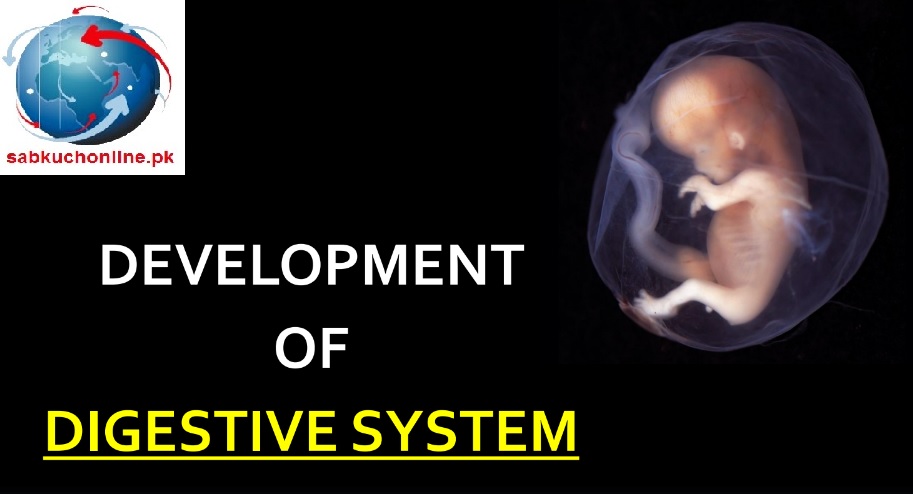The gastrointestinal tract
(digestive tract/ digestional tract/ GI tract/ GIT/ gut/alimentary canal)


- Explain how the primordial gut forms?
- Identify the germ layer involved in the
formation of gut wall. - Identify the divisions of gut tube
- Enumerate the derivatives of foregut
- Describe the development of esophagus
- Correlate development of esophagus with
its relevant congenital anomalies
- Describe the development of stomach
- Demonstrate rotation of stomach with the help of model
- Correlate rotation of stomach with its nerve supply
- Discuss the formation of dorsal and ventral mesentry and
structures taking origin from them - Correlate development of stomach with its relevant
congenital anomalies - Describe the development of Duodenum, liver and
pancreas - Correlate development of Duodenum, liver and pancreas
with relevant congenital anomalies
How the primordial gut forms?
The primordial gut forms during 4th week as the head, tail, & lateral folds incorporate the dorsal part of
umbilical vesicle into the embryo


FOLDING OF EMBRYO






GERM LAYERS INVOLVED IN FORMATION OF GUT


DIVISION OF PRIMITIVE GUT

DERIVATIVES OF FOREGUT

DEVELOPMENT OF ESOPHAGUS




▪ Reaches at final length by 7th week
▪ Elongation of esophagus (due to growth & relocation of
heart & lungs
▪ Tracheoesophageal ridges Tracheoesophageal
septum
▪ Division of foregut proper into two
Proliferation of endodermal epith …. during week
5 & 6
Recanalization by apoptosis ….. By the end of week 8

▪ Esophagus:

CLINICAL CORRELATES OF DEVELOPMENT OF ESOPHAGUS

Esophageal atresia Polyhydramnios


DEVELOPMENT OF STOMACH




POSITIONAL CHANGES OF STOMACH
Stomach rotates around:
- Longitudinal (craniocaudal) axis
- Anteroposterior axis

EFFECTS OF ROTATION ON STOMACH
▪ Around longitudinal axis (900 clockwise, viewed from cranial end)
Boarder Surface
▪ Around AP axis:
End
Long axis of stomach is downward & to right (almost at right angle to long axis of body
Rotation & growth of stomach explain why left vagus nerve supplies anterior wall of adult stomach and right vagus innervates its posterior wall

MESENTERIES OF STOMACH/ MESOGASTRIUM

▪ Definition of mesentry
▪ Intraperitoneal &
retroperitoneal organs
▪ Peritoneal ligaments
▪ Function of mesentry and
peritoneal ligaments
▪ Mesenteries in 4th wk
▪ Mesenteries in 5th wk
Extent of dorsal mesentry
Extent of ventral mesentry
▪ Mesentry proper

ROTATION & DISPROPORTIONATE GROWTH OF STOMACH ALTER THE POSITION OF THESE MESENTERIES
FORMATION OF LESSER SAC


DEVELOPMENT OF SPLEEN
Derived from a mass of mesenchymal cells
located between layers of dorsal mesogastrium
▪ The spleen appears about the sixth week as a
localized thickening of the coelomic epithelium of
the dorsal mesogastrium near its cranial end
▪ The proliferating cells invade the underlying
angiogenetic mesenchyme, which becomes
condensed and vascularized.
▪ The process occurs simultaneously in several
adjoining areas which soon fuse to form a lobulated
spleen of dual origin (from coelomic epithelium and
from mesenchyme of the dorsal mesogastrium).
The enlarging spleen projects to the left, so that
its surfaces are covered by the peritoneum of the
mesogastrium on its left aspect, which forms a
boundary of the general extrabursal (greater) sac.
When fusion occurs between the dorsal wall of
the lesser sac and the dorsal parietal peritoneum,
it does not extend to the left as far as the spleen,
which remains connected to the dorsal abdominal
wall by a short lienorenal ligament.
Its original connection with the stomach
persists as the gastrosplenic ligament. The
earlier lobulated character of the spleen
disappears, but is indicated by the presence
of notches on its upper border in the adult.






Effects of rotation of stomach on surrounding structures
1.Lesser sac
2.Final position of spleen & its ligaments
3.Final position of pancreas
4.Greater omentum
5.Lesser omentum
6.Falciform ligament
DORSAL MESOGASTRIUM
1.Dorsal mesogastrium/ greater omentum
2.Dorsal mesoduodenum
3.Dorsal mesocolon
4.Mesentry proper
VENTRAL MESOGASTRIUM
1.Lesser omentum
2.Falciform ligament



DEVELOPMENT OF DUODENUM

Early in 4th week
Terminal part of foregut,
cephalic part of midgut &
splanchnic mesoderm associated
with these parts of primordial gut
Formation of C shape loop
Plane of loop
Loop swing to right (due to rotation of stomach & rapid growth of head of pancreas
Retroperitoneal





DEVELOPMENT OF LIVER







4 th week of development
HEPATIC PLATE
Endodermal epith of ventral wall of caudal part of foregut
HEPATIC BUD/ DIVERTICULUM
In the form of an outgrowth of rapidly proliferating cells
Diverticulum grows ventrally & upwards towards ST
Divides into 2 parts
Cranial part
Caudal part

From 5 th to 10 th week……liver grows rapidly
Size of lobes
In 6 th week …..hemopoiesis begins
In 10 th week ….. Liver accounts for 10% body wt fetus
In 12 th week ….. Bile formation by hepatic cells start
Formation of lesser omentum & falciform ligament

DEVELOPMENT OF PANCREAS







